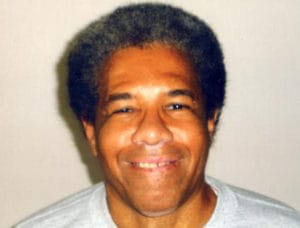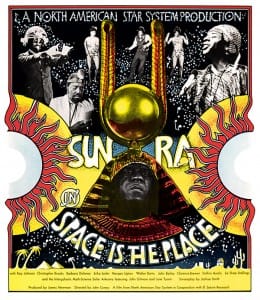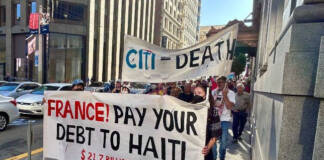Given the trajectory of 2014 regarding Black lives, perhaps February would be a great time to reflect on what bell hooks calls “the love ethic,” a principle Dr. King embodied and preached. This belief is illustrated theatrically in the film “Selma,” when King calls off the second attempt to cross the Edmond Pettus Bridge. He says he could not lead the people into a bloodbath. He waited until after the court battle was won, and the march was completed without casualty.
Langston Hughes would have been 116 on Feb. 1 (his mother, Carrie Langston, was born Jan. 22, 1873). Albert Woodfox will be 68 on Feb. 19. Hopefully he will be eating cake under some sunny sky, a freed man by then. Send cards to Albert “Shaka” Woodfox, 72148, David Wade Correctional Center, 670 Bell Hill Rd., Homer, LA 71040. Visit http://angola3news.blogspot.com/.
Correspondence between Carrie Hughes and her son, Langston
“My Dear Boy: Carrie Hughes’s Letters to Langston Hughes 1926-1938,” edited by Carmaletta M. Williams and John Edgar Tidwell, published in 2013, is a look at how many of Hughes’ poems and stories are in response to correspondence between him and his mother. A dutiful son, Hughes tried to make his mother happy and responds affirmatively to Carrie’s demands, even when such are not practical or always possible. A frustrated actress, she spends most of her life trying to keep up appearances, living extravagantly via her two boys, one weak and the other, Langston, a lot stronger.
The Langston Hughes we meet in this correspondence is not well known; well known is the work of the period, but not the inner boudoir intrigue. Editorial commentary weaves together the story of a man who, like James Baldwin, spoke to the African American position in this country. Abandoned by his mother at 6, living with his maternal grandmother off and on for several years – between husbands – Langston rejoins his mother, new brother and second husband in 1915, after a stay with the Reeds, family friends. But in 1917, the teenager is left behind once again, this time alone in an attic apartment in Cleveland.
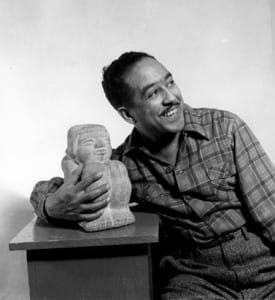
“My Dear Boy” looks at what drives Carrie to abandon her son, Langston. When Carrie was young, her mother did not support her daughter’s desire to continue to lead an artistic and intellectual life – one she’d been groomed for. Granted, the death of her father left the family to experience hardships, yet in many ways Carrie’s life also ceased and so did her happiness.
She was not able to develop a “realistic interdependence, (where) … (she and her mother) could have helped the other and both retained their individuation.” The Carrie we meet in this correspondence is a woman who tries to fill a psychic emotional void with position, pride and possessions. She tries to buy happiness, even though such purchases seldom do.
Hughes nonetheless tries to stay close to his mother and brother, Gwyn Clark, even though his mother seems only desirous of his company as long as he pays her bills. It is a relationship of guilt, shame and bribery all in the name of love. That Hughes can turn what looks to be an impossible relationship into one of care and concern, tolerance and acceptance both practically and aesthetically is a lesson for all those who would and have thrown up their hands and severed such relationships.
He never cut his mother off emotionally or practically – such gives Hughes an even greater legacy, one not previously tackled academically before editors Williams and Tidwell’s amazing work. Listen to my interview, at http://www.blogtalkradio.com/wandas-picks/2014/03/19/wandas-picks-radio-show-my-dear-boy-carrie-hughess-letters-tolangston-hughes.
The interchange between Self and Word examined in the “epistolary conventions” between mother and son reveal “an inextricably linked emotional connection between Carrie’s desperate pleas to Langston and his aesthetic response to her demanding entreaties. Thus the ‘interface’ in her letters is a two-way process between writer and recipient: there is communication with Langston and a revelation of deep insight into her Self” (2-3). Such insightful analysis “offers her life as a shaping influence on Langston’s art. … By inscribing their relationship as a series of familial conflicts, Langston confronts their family ties indirectly, via (his work). This places his mother’s relationship to her well-known writer son in a wholly new perspective” (3).
Hughes travels a lot during the time of this correspondence, so the literal and physical landscape allows Hughes a palette wherewith to explore, perhaps not always consciously, the maternal shadow dripping on his horizon. Hughes is affected certainly, but not immobilized by this yearning for his mother’s love. Umbrellas do not shield him from the humidity – a trench coat, his perpetual psychic garment of choice.
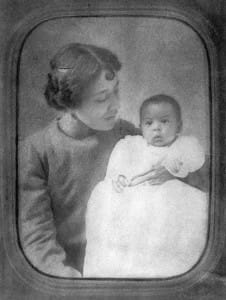
In “My Dear Boy” we also learn of Hughes’s ancestral legacy of resistance: from a grandfather who died during the battle at Harper’s Ferry, to whom President Roosevelt gives a commendation in 1859 along with the “bullet-riddled, bloodstained shawl he wore at his death” (xxiii), and an Uncle Langston, who has an all-Black town named after him 12 miles from Guthrie, Oklahoma Territory – it is here that his mother meets his father, James Nathaniel Hughes – to uncles Nat Turner (Langston) and Dessalines (Langston), one sees where Hughes’ attempt at what the authors call “self-differentiation or his ability to adhere to (his) own principals regardless of the degree of emotional pressure (he) experiences” is more successful than his mother’s given the time and circumstances she was born (9).
The context the authors provide for this relationship between a loving son and his mother provide another important layer of analysis of Hughes’ work. Unlike James Baldwin, who shares much of his parental struggles with his audiences in his many essays, especially the seminal “Notes of a Native Son” and his “The Fire Next Time” and “Nobody Knows My Name: More Notes of a Native Son,” this internal landscape is hidden in more popular scholarship.
We never hear Hughes responses to his mother in “My Dear Boy,” just his mother’s interpretations of the letters she receives. Hughes’ response is literary, it is public, it is massive … yet few know where the inspiration lay for these plays or poems written in the 1920s and 1930s. The authors liken their structure of “My Dear Boy” to “a call and response” (163). The character Jesse B. Simple emerges at this time. “This doppelganger structure … is a form of masking (used by) Langston to veil or protect himself from the penetrating eyes of those who would seek to know him more intimately. His masking permits him to share as much as he cares to about his inner life” (165).
Hughes never complains; he just writes. If Hughes’ alter-ego is Jesse B. Simple, in contrast, the authors attest that not one character can hold his mother Carrie’s persona (smile). She forms the basis for three characters in her son’s first novel, “Not Without Laughter”: Tempy, Aannjee and Harriett (166). “My Dear Boy” points to the power of the “word” to open psychic territory or landscapes for healing to take place.
25th African American Celebration through Poetry
The 25th Annual African American Celebration through Poetry is Saturday, Feb. 7, 1-4 p.m., at the West Oakland Branch of the Oakland Public Library, 1801 Adeline St. Everyone is invited to join Black poets in celebrating the African American literary tradition. This year we are honoring writer and activist Maya Angelou and West Oakland artist Arnold White. The theme is “And Still I Rise.” The event is free to the public. There will be refreshments, including a cake (smile). If you missed the rehearsal, no worries, bring a poem to share during the open mic portion of the program. For questions, call 510-238-7352 or send an email to info@wandaspicks.com. We still need help with setup and at the refreshment table.
Black Arts Movement at Laney College
The Black Art Movement West at 50 Years celebrates with workshops and art exhibit and book fair, Feb. 7, 10-8 at Laney College, 900 Fallon St. in Oakland. The day long program is free. Visit http://blackbirdpressnews.blogspot.com/2014/12/marvin-x-recruits-black-arts-movement.html or call 510-200-4164 or jmarvinx@yahoo.com
Bryan Keith Thomas’ ‘Heirloom’ at Joyce Gordon Galley
Join artist Bryan Keith Thomas in an intimate conversation about his latest work, Friday, Feb. 6, 6-9 p.m., at Joyce Gordon Gallery, 406 14th St., in Oakland. The talk begins at 7 p.m. It is a free event.
For those familiar with the brilliant painter’s work, you will notice the references to antebellum South, cotton, roses, bibles sitting on the piano at the door to the gallery – all emancipation stories, important to reference, ‘cause, case you haven’t heard, we still ain’t free.
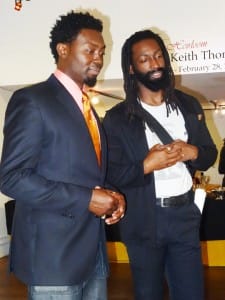
Gen. Harriet Tubman, Huey P. Newton and the iconic church fans are a few works instantly identifiable. Tubman stares from a large canvas – part of the series, the artist told me opening night. Newton is also present. He’s a bit harder to locate – framed by an Afro-pick with an African statue holding the framed ancestor.
New to the work, which includes homage to Black love – a former slave couple pictured at 100-plus years of age seated, Black babies and young Black men as spirits rising – are the gris gris or medicine spirit bags which grace each installation or painting. It is if the figures are alive and walking. “Creole,” a painting of a bereaved lighter hued woman, steps from the canvas, her broach inviting touch as her skirt is covered in these handmade bags with bereavement or mourning jewelry, seashells and other ornaments like twine.
The artist said each bag contains biblical tracts and was dipped in paraffin, left outside to weather and or sprinkled with oils or herbs.
The presentation here is at once holy and sacred, but then all of Bryan Keith Thomas’ work is imbued with this kind of consciousness. Archetypal references to resistance across generations is also not lost on viewers as the images of Africa collide with those of America or the Diaspora, the young and the old, male and female.
The African Diaspora is presented here, not as separate, rather connected as if there was no riff or separation, but the pain and suffering framed or mounted here is evidence to the contrary. Art has a way of bridging or narrowing time, almost disappearing the interludes, but Thomas’ work takes place in the interlude.
It is as if he is saying: do not forget.
Painted on weathered wooden surfaces, each piece carries multiple stories – the surface or transport just as important as what it carries. In the work with the young man, eyes closed, next to another picture, eyes open – the surfaces are the back of two church pews. Other surfaces are antique basins, wooden cutting boards, rain stained sidings from a Victorian home. Thomas says his studio is a collection of surfaces which call to him when he is working in images.
Opening night, while I waited for Keith to arrive, I was intrigued by the necklace made from hair, and the bronze slices of watermelon and the open bible – the work of another artist featured at Joyce Gordon, Andrew Wilson. In the case were books one had to wear white gloves to handle – one book is ceramic and is about slavery and emancipation, the other is a son speaking to his father – all the photos of different men are at a barbershop.
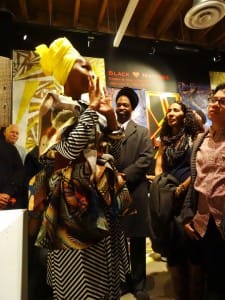
The last and perhaps the most beautiful work is a suite of poems looking at the beauty of Black me. The photos are nude and the words follow the curves of different parts of the model’s body, whether that is his hands or the curves of his back, his neck, his arm. The artist’s work is amazing, yet more perhaps amazing is his ability to invoke a language that resonates as much as it captures, sometimes with humor, the lovely work.
There is more of Wilson’s work on the walls in the back; then in the smaller gallery is the work of another artist which is also quite good. The combination of these two artists’ work with Brian Keith Thomas’ work makes this show one of the best I have seen in a long while. The subtlety of the work lingers like a gentle breeze which gets into your pocket, clings to your neck – makes you warm and a bit uncomfortable, but not too much, which is what art is all about.
Up the street at Impact Hub, Oakland’s Omni Gallery, was another exhibit by Karen and Malik Seneferu. That same Friday night the party was certainly happening there, with a huge audience and a really nice artist reception complete with a new film by Karen, music by Tarika Lewis and a lovely singer, and an artist talk after we walked through the gallery.
Always healing and centered in the Black or Pan African aesthetic, this work by Karen Seneferu features an altar and a matrix both on the wall and the floor and in the window. Malik’s work continues a series he has been adding to over the years, which also has reoccurring motifs – arrows which he says are a neo-Sankofa design, along with spirals. Marcus Garvey and Assata Shakur show up along with Basquiat in the new work. There is an intimacy in the gallery, which is small – not small enough to be able to turn around and touch all the walls with one’s hands outstretched, but if there were you and two friends, you certainly could, which is to show how literally we are only three degrees separated.
Inside Sister Karen’s medicine cabinet are blue rooster feathers, a gift from her rooster friend in Richmond, and other medicine. See http://oakland.impacthub.net/omi-gallery/.
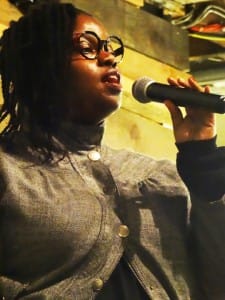
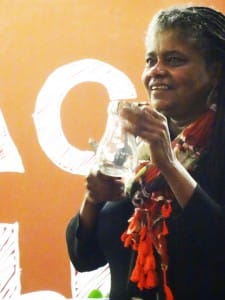
Black Like Me in America
Each Friday in February – Feb. 6, 13, 20, 27 – at 7 p.m., Bryant Bolling will be performing his one man musical, “Black Like Me In America, A Musical Journey Through Slavery,” at the Altenheim, 1720 MacArthur Blvd. in Oakland. The event is free; however, donations are accepted.
Bollings’ original performance tells the story of a newly emancipated man who was enslaved in Talbert County, Maryland, for over 30 years. The playwright-actor incorporates the use of Negro Spirituals and poetry. This is an historical account with slides depicting a broader spectrum of the African-American experience as a backdrop to his performance. The work is a moving, yet entertaining journey through a period in history that continues to be difficult to discuss to this day. All are invited. Please spread the word!
Benefit for Zimbabwean Orphanage, Mother of Peace
“Lift Ev’ry Voice and Sing: An Intercultural Celebration of African-American Song from Slave Ships to Selma” to benefit Mother of Peace Orphanage in Zimbabwe is Sunday, Feb. 22, 7 p.m., in the sanctuary at First Church Berkeley, 2345 Channing Way, Berkeley. For information, call 510-465-2797 or info@fccb.org and www.fccb.org.
African Cinema at Berkeley Art Museum Pacific Film Archive
Kathy Geritz, BAM/PFA film curator, states about PFA’s African Film Festival, “Liberation movements in Africa – both today and in the past – are a focus of this year’s edition of our annual African Film Festival. The festival, which began in January, continues with two more screenings this month:
“Sambizanga” (102 minutes) will be screened Wednesday, Feb. 11, 7 p.m. One of the first feature films made by a woman in Africa, Sarah Maldoror (Angola/Congo, 1972), this film is an urgent call for political change. The events leading up to a 1961 prison rebellion in Angola form the plot. “Maldoror is both presenting history and issuing a call to arms,” according to the Village Voice review.
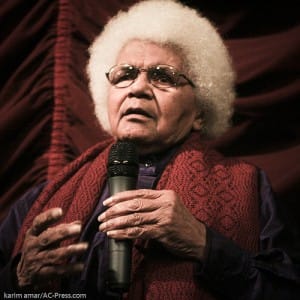
“Sarah Maldoror: Films of Resistance” (57 minutes) will be shown Thursday, Feb. 12, 7 p.m. Sarah Maldoror attended film school in Moscow with Ousmane Sembène and worked on “The Battle of Algiers” before becoming one of African cinema’s first women directors and one of its most passionate voices. Shorts include “Monangambée” (1968), “Carnival in Guinea-Bissau” (1971), and Mathieu Kleyebe Abonnenc’s recent excavation of Maldoror’s lost film, “Guns for Banta.”
“Cassa Cassa! Danced Encounters Between Africa and Its Diaspora” (86 minutes) will screen Tuesday, Feb. 17, 7 p.m. Elodie Lefebvre (Senegal, 2013) is the director. In 2007, artists, choreographers, dancers and musicians from across Africa and its diaspora gathered in a remote Senegalese village for communion, connection and inspiration. This documentary captures their passion and commitment. Alla Kovgan and David Hinton’s short, “Nora,” featuring the choreographer Nora Chipaumire, will also be shown.
Pacific Film Archive Theater is located at 2575 Bancroft Way, Berkeley. For information, call 510-642-1124, and for tickets, call 510-642-5249. Visit http://bampfa.berkeley.edu and www.facebook.com/bampfa. General admission is $9.50 for one program, $13.50 for double bills. BAM/PFA members, children and UC Berkeley students, faculty and staff get in for $5.50 and $9.50. For other students, young people (13-17), seniors and disabled persons, admission is $6.50 and $10.50.
Cuban films at MoAD
“Art and Resolution: Films of Afro-Cuban Life and History” are Thursdays, Feb. 5, 12 and 19, at 6:30 p.m. at the Museum of the African Diaspora, Mission at Third Street in San Francisco, www.moadsf.org. Curated by Cornelius Moore, the series offers a rare look at Cuban life – especially the first film in this series, which is directed by Sara Gómez, the only Afro-Cuban woman director in a leading role at the Cuban Film Institute in its early years. Her work, “In One Way or Another” (1974, 78 minutes), “brings together Afro-Cuban cultural traditions (including Abakúa and Santería), gender issues, workers’ rights, revolutionary social organization and the treatment of marginalized sectors of society. Although Gómez died shortly before completing the film, her work remains among the most significant of the 20th century,” according to the program notes. Listen to an interview with the film curator: http://tobtr.com/s/7233251.
 ‘Space is the Place’ 40th anniversary screening and talk
‘Space is the Place’ 40th anniversary screening and talk
For the 40th anniversary release of Sun Ra’s musical Afro-futurist film, “Space is the Place” (1972, 85 minutes), The Contemporary Jewish Museum, 736 Mission St. in San Francisco, presents a screening of the film “Space is the Place,” followed by a talk with producer Jim Newman and musicologist David Katznelson. “Space is the Place” is a musical jazz journey following band leader Sun Ra (1914-1993) and his Intergalactic Myth-Science Arkestra as they land their yellow spaceship in Oakland and then go searching for a homeland. The cost is $5 for CJM and MoAD members and $10 general admission.
Lecture by Rev. Dr. Jeremiah A. Wright Jr. at MoAD Feb. 8
#Did Black Lives Ever Matter? is the question explored by Rev. Dr. Jeremiah A. Wright Jr. on Feb. 8, 3-5 p.m., at MoAD, Mission at Third Street in San Francisco. Tickets are $25 general admission and $20 for MoAD members.
Rev. Dr. Wright became pastor of Trinity United Church of Christ in 1972. A student of Black sacred music, ethnomusicology and African Diaspora studies, Dr. Wright is an historian of religions. He has lectured at seminaries and universities across the United States and has represented Trinity United Church of Christ and The United Church of Christ around the world. He is recognized as a leading theologian and pastor and has authored numerous articles for academic journals. At the end of May 2008, Dr. Wright retired as senior pastor of Trinity United Church of Christ and now spends his time preaching, teaching and leading study tours to Africa, Brazil and the Caribbean.
Kahil El’Zabar and The Ethnic Heritage Ensemble
A Valentine Jazz Night at EastSide Cultural Center, 2277 International Blvd., Oakland, is Saturday, Feb. 14. The event features Kahil El’Zabar and The Ethnic Heritage Ensemble, featuring Kahil El’Zabar on percussion, Ernest Dawkins on saxophone, Corey Wilkes on trumpet, plus special guest artist, John Santos. El’Zabar and the Ethnic Heritage Ensemble are celebrating the 50th anniversary of the Association for the Advancement of Creative Musicians (AACM). For information, call 510-533-6629 or visit www.eastsideartsalliance.org. Tickets are $20 or two for $30. There will be the concert, dancing and bar. Visit http://www.kahilelzabar.net/.
On the fly
The Art of Living Black at the Richmond Art Center opens Feb. 7; visit http://richmondartcenter.org/exhibitions/19th-annual-art-living-black/. “Mighty Real, A Fabulous Sylvester Musical” is at Brava, Feb. 11-March 1, http://www.brava.org/. The film “Timbuktu,” directed by Abderrahmane Sissako, continues at Sundance Kabuki in San Francisco, https://www.sundancecinemas.com/.
African American Shakespeare Company presents Nambi E. Kelley’s “Xtigone” Feb. 14-March 8 at the Buriel Clay Theatre, African American Art and Culture Complex, 762 Fulton St., San Francisco. Tickets are $15-$34. Visit http://www.african-americanshakes.org/productions/xtigone/. With “Xtigone,” written by a woman, directed by a woman and starring a woman in an adaptation of a 2,500-year-old play, where the main protagonist is a woman, the African-American Shakespeare Company continues its 20th anniversary season with a recontexualization of the play into a modern milieu of gangs, violence and retribution, where it is the women who are left to navigate the consequences as they bury the dead and the fallen. The play is authored by Nambi E. Kelley, directed by Rhodessa Jones and stars Ryan Nicole Austin, with an original Hip Hop score from Tommy (Emcee Soulati) Shepherd.
Danai Gurira’s “The Convert,” directed by Jasson Minadakis, Marin Theatre Company artistic director, has its Bay Area premiere at the theatre, 397 Miller Ave., Mill Valley, Feb. 19 through March 15. The place is Southern Africa, 1896. An impossible choice. Against her family’s wishes, a young Shona girl escapes a forced marriage arrangement by converting to Christianity and becoming a servant and student to an African evangelist. However, as anti-European sentiments rise among her people, she must choose between colonial and ancestral ways of life. Recommended for mature teens and up.
Poetry Reading highlights ground breaking anthology that blends social activism and literature
“Fightin’ Words: 25 Years of Provocative Poetry and Prose from ‘The Blue-Collar’ PEN” poetry reading and reception is Tuesday, Feb. 10, 6:30-9 p.m., at Berkeley City College Auditorium, 2050 Center St., Berkeley. Featured are award-winning authors Lucille Lang Day, Jack and Adelle Foley, Rafael Jesús González, Kirk Lumpkin, Mary Mackey, devorah major, Kim McMillon, Claire Ortalda, Tony Rodríguez, Floyd Salas and Richard Silbert. Sharon Coleman will emcee this event.
This is an opportunity to meet many of the diverse cultural voices that are highlighted in this ground-breaking new work edited by Judith Cody, Kim McMillon and Claire Ortalda. For more information, please call (510) 681-5652.
‘Da Cotton Pickas’ at La Peña
Screening of “Da Cotton Pickas: The Justification and Journey of a Sharecropping Cotton Picka” is Wednesday, Feb. 21, 4-6 p.m., at La Peña Cultural Center, 3150 Shattuck Ave., Berkeley, www.lapena.org. Watch the trailer at https://www.youtube.com/watch?v=OB6ELsWHgtw&feature=youtu.be.
Directed by Robert “Fleetwood” Bowden, “Da Cotton Pickas” explores the trials and tribulations of Southern cotton plantation workers following the abolition of slavery in America. It uncovers the sharecropping arrangements between cotton pickers and the landowners, who regularly denied them their wages, taking you through their journey as they left their homes and even their families to travel west and north.
We meet minister and activist Bishop Henry C. Williams, born in 1934 on a sharecropper’s plantation in Alabama, who has spent decades fighting for reparations. Through his story we learn the sad state of economics awaiting so many migrants when they finally arrived to what had been sold to them as the promised land. This project confronts the ghost of slavery that still haunt America and the unexpected ways its chains have yet to be broken.
The film offers a unique perspective on race relations and opens up a dialogue to foster better understanding of the past and present while focusing on what’s possible for America’s future. It allows for engaging moments that will build a much-needed bridge between the youth and elders of our community.
A MECA for Peace event: ‘Reel Bad Arabs: How Hollywood Vilifies a People’

“Reel Bad Arabs: How Hollywood Vilifies a People” will be shown at La Peña on Monday, Feb. 26, 7 p.m. This screening will be followed by panel discussion, “Challenging Islamophobia,” with Lara Kiswani from Arab Resource and Organizing Center, Samia Shoman from Teaching Palestine and more!
The film features acclaimed author Dr. Jack Shaheen as he explores a long line of degrading images of Arabs –from Bedouin bandits and submissive maidens to sinister sheikhs and gun-wielding “terrorists” – along the way offering devastating insights into the origin of these stereotypical images, their development at key points in U.S. history, and why they matter so much today – reinforcing a narrow view of individual Arabs and the effects of specific U.S. domestic and international policies on their lives. The film challenges viewers to recognize the urgent need for counter-narratives that do justice to the diversity and humanity of Arab people and the reality and richness of Arab history and culture.
La Peña Cultural Center is located at 3150 Shattuck Ave., Berkeley, www.lapena.org. Tickets are $10-$15 sliding scale for this benefit for children in Palestine. For info, contact 510-548-0542 or meca@mecaforpeace.org.
Bay View Arts Editor Wanda Sabir can be reached at wanda@wandaspicks.com. Visit her website at www.wandaspicks.com throughout the month for updates to Wanda’s Picks, her blog, photos and Wanda’s Picks Radio. Her shows are streamed live Wednesdays at 7 a.m. and Fridays at 8 a.m., can be heard by phone at 347-237-4610 and are archived at http://www.blogtalkradio.com/wandas-picks.





